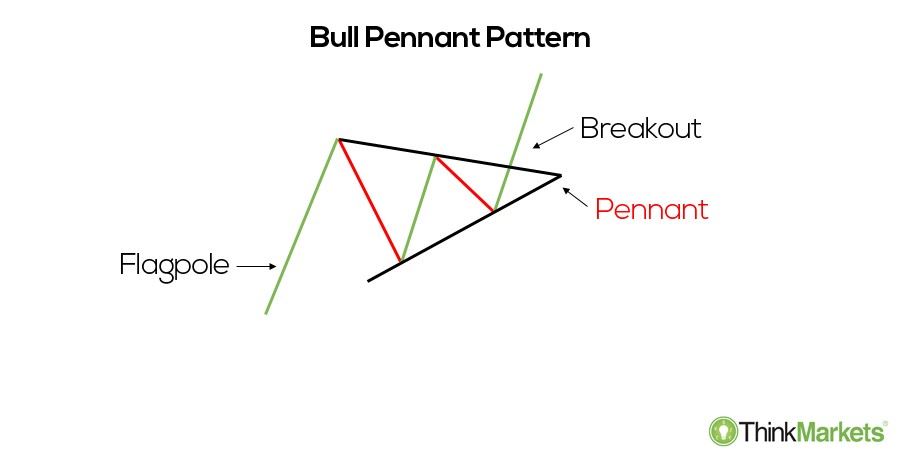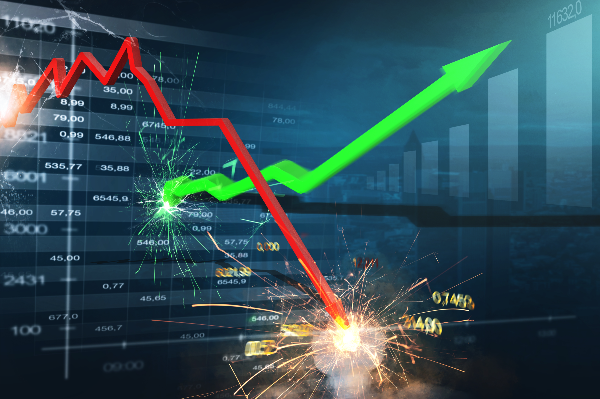Who Buys Stocks When Everyone is Selling?
When there is a market sell-off, market makers, traders and long term value investors are on the other side of the trade buying these stocks at discounted prices. Trades can be completed almost instantaneously, and so prices can rapidly adjust to find buyers in the market. Since the stock market is efficient, sellers during a sell-off can find a buyer, but the trade-off for this convenience is selling their stock at a significant loss.
Why Traders Buy During a Sell-off
Traders buy during a sell-off because they are seeing a short term pattern that confirms a relief in selling pressure. This relief could be for a day, it could be just a few minutes, and for algorithmic traders, it could be seconds. Traders are not betting the sell-off has ended. They are indifferent to the overall market direction. The trader is buying only because they believe they can sell for a profit within a short time frame.
 A bull penant pattern is an example when a technical trader will buy during a sell-off for a short term gain.
A bull penant pattern is an example when a technical trader will buy during a sell-off for a short term gain.
Why Market Makers Buy During a Sell-off
Market makers provide liquidity to the markets by being a buyer and a seller to participants in a stock or ETF. Market makers earn profits by making bids and offers on stocks that are advantageous to them.
For example, a market maker may buy Amazon stock at $2000, and immediately sell to other participants at $2010. Market makers profit from the bid-ask spread by providing liquidity.
During a sell-off, market makers continue to provide liquidity to the markets; however, they will demand much lower prices, which can cause sudden cliffs in the market price.
Why Long Term Investors Buy During a Sell-off
Long term investors buy during a sell-off because they believe the intrinsic value of the stock is higher than the price the stock has fallen to. Long term investors are typically the last market participants to buy during a sell-off, as they want to buy when they perceive a good deal.
Tips for Beginners During a Sell-off
During a sell-off, look to buy quality stocks to hold for the long term. Calculate the intrinsic value of a the stock first. Then, if the stock falls to its intrinsic value, buy just a small amount. Do not get over excited when the stock reaches the intrinsic value. Take a deep breath and wait at least two weeks to two months. Momentum will likely drive the stock price further below the intrinsic value due to the markets fear, irrational behavior, and the fleeing of momentum investors. See the full guide of beginner investor tips to learn more about investing.












Who Buys Stocks When Everyone is Selling?
When there is a market sell-off, market makers, traders and long term value investors are on the other side of the trade buying these stocks at discounted prices. Trades can be completed almost instantaneously, and so prices can rapidly adjust to find buyers in the market. Since the stock market is efficient, sellers during a sell-off can find a buyer, but the trade-off for this convenience is selling their stock at a significant loss.
Why Traders Buy During a Sell-off
Traders buy during a sell-off because they are seeing a short term pattern that confirms a relief in selling pressure. This relief could be for a day, it could be just a few minutes, and for algorithmic traders, it could be seconds. Traders are not betting the sell-off has ended. They are indifferent to the overall market direction. The trader is buying only because they believe they can sell for a profit within a short time frame.
 A bull penant pattern is an example when a technical trader will buy during a sell-off for a short term gain.
A bull penant pattern is an example when a technical trader will buy during a sell-off for a short term gain.
Why Market Makers Buy During a Sell-off
Market makers provide liquidity to the markets by being a buyer and a seller to participants in a stock or ETF. Market makers earn profits by making bids and offers on stocks that are advantageous to them.
For example, a market maker may buy Amazon stock at $2000, and immediately sell to other participants at $2010. Market makers profit from the bid-ask spread by providing liquidity.
During a sell-off, market makers continue to provide liquidity to the markets; however, they will demand much lower prices, which can cause sudden cliffs in the market price.
Why Long Term Investors Buy During a Sell-off
Long term investors buy during a sell-off because they believe the intrinsic value of the stock is higher than the price the stock has fallen to. Long term investors are typically the last market participants to buy during a sell-off, as they want to buy when they perceive a good deal.
Tips for Beginners During a Sell-off
During a sell-off, look to buy quality stocks to hold for the long term. Calculate the intrinsic value of a the stock first. Then, if the stock falls to its intrinsic value, buy just a small amount. Do not get over excited when the stock reaches the intrinsic value. Take a deep breath and wait at least two weeks to two months. Momentum will likely drive the stock price further below the intrinsic value due to the markets fear, irrational behavior, and the fleeing of momentum investors. See the full guide of beginner investor tips to learn more about investing.